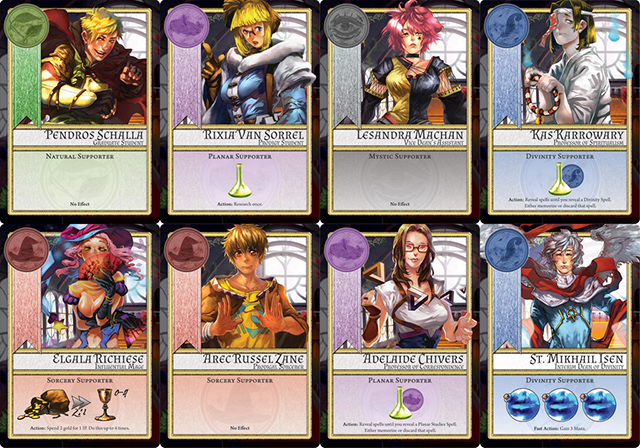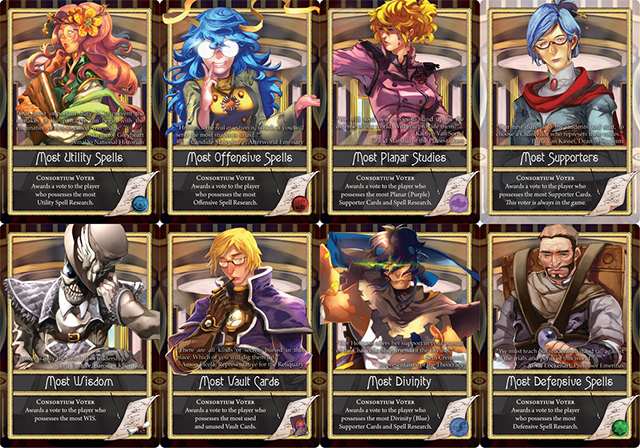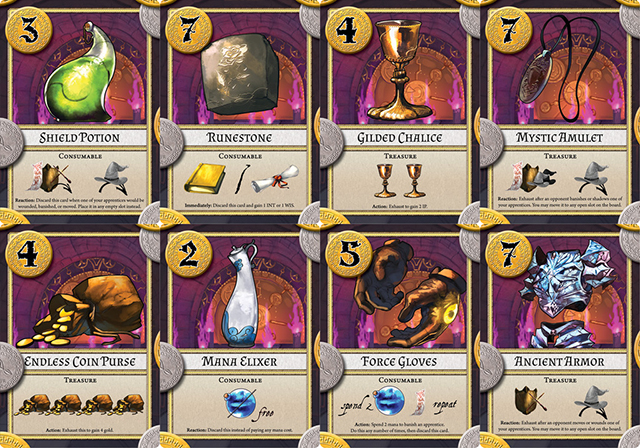
I really appreciate good world-building. For me, the sign of a solid, well-crafted setting is the ability to re-use it in other creations beyond the original and its sequels or expansions. This isn’t something that happens in the board game world very often without a licensed property being involved. A good recent example is Fantasy Flight Games’s Android universe, which spun off into Infiltration and served as a natural fit for the revival of Netrunner.
Level 99 Games has now done something similar, taking its World of Indines, most notably seen in its BattleCON Street Fighter-style fighting games, and exploring one of its key locations: Argent University. Argent is a school for mages, sort of a post-graduate Hogwarts, and for the purpose of this game its Chancellor has just announced his retirement. The players represent high-ranking members of the school’s various departments, each vying for the vacant post. In order to achieve this, they must win the favor of the secret consortium (thus Argent: The Consortium) who will cast their votes to determine the new Chancellor.

Each player has a number of student mages at their disposal, and the bulk of the game is worker-placement with a twist: each department’s students have their own unique abilities that makes them more than mere workers. For example, Divinity mages can not be affected by the spells of opponents, while Mysticism mages are able to be placed for free every time you cast a spell on your turn. Your specific configuration of powers will depend on which mages you draft from the available pool at the beginning of the game, but you can never have more than two from the same department.
On a player’s turn, they may first execute a fast action. These are specially-indicated skills that can only be used at this time. Then they take one regular action: placing a mage, casting a spell, using a Supporter or Treasure card they have acquired or claiming a Bell Tower card and its effects. Players take turns executing actions until the final Bell Tower card is claimed, which ends the round whether other players have potential actions left or not! After this Errand Phase, placed mages collect their rewards and then a new round begins. After five rounds (normally), the game ends and votes are tallied. Whoever has the most votes wins.

Voters each have specific and unique criteria for who earns their vote. The catch is that ten of the 12 voters are secret! Players can use some actions or rewards to earn marks, which allow them to look at one voter and learn their requirement. Knowing how to earn some votes is handy, but if you’re too obvious in going after the votes you know are available, your opponents might pick up on it and deduce relevant knowledge for free. Unless you’re bluffing, of course…
At its core, this is all there is to Argent: The Consortium. But the details are so much deeper. The board where mages are placed consists of a player-dependent number of different rooms in the University drawn at random during set up, and each with two versions. Every space in every room has a different reward for having a mage there during the Resolution Phase. Some of those rewards involve gaining one of three different types of available card (Supporter, Vault or Spell) from a constantly-changing tableau of each, and of course every card has its own unique effect. Spells have as many as three if you invest research into developing them! And of course all of these various objects are potentially valuable if the right voters are in the consortium.
Argent also has options for further variety beyond that inherent in every game. There are alternate mage powers, a possible additional round, scenarios that change the rules each round and an expansion, Mancers of the University, that contains even more possibilities — including an additional department of magic that allows the game to support up to six players instead of the base game’s five.

As you can see, Argent offers almost-limitless replayability without ever being exactly the same game twice. This complexity comes at a price, however. While the basic game mechanics are simple, the complicating factors of each permutation add up quickly, especially in later rounds when players might have picked up additional mages or a large library of spells at their disposal. As a result, a game session averages at thirty minutes per player but the wealth of options can potentially overwhelm even the best to drag that out, especially in early games where everyone is still getting a grip on things.
Fortunately, the game itself is fairly easy, and makes liberal use of icons to represent actions for quick reference. The only real flaw that I could find is with the mage pawns themselves, or rather the badges that each player uses to mark the ones belonging to them. Many of these badges are dark and hard to identify from across the table, which can be a nightmare. My friends and I have taken to making sure that we place mages with their badges facing their owner to help keep track of who is where and that helps. Speaking of the table, I hope you have a big one because Argent is going to demand a lot of space, especially with a large player count (which also means a larger University set-up).

As worker-placement games go, Argent stands up against the best thanks to its unique features. More importantly for me, it gives me an opportunity to visit a world that I enjoy without having to resort to what is normally a game for only two players, which makes a huge difference when you have a regular gaming group. (Argent can also support two, but that is recommended for experienced players only.) Devastation of Indines was my favorite game of last year, and I have to imagine that Argent: The Consortium will finish highly at the end of this year as well.
Argent: The Consortium retails for $60; Mancers of the University for $40.



















